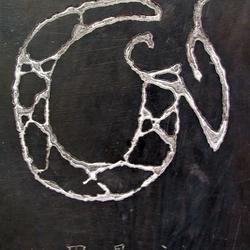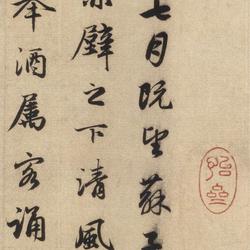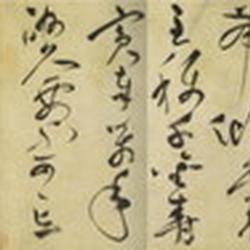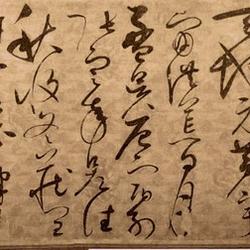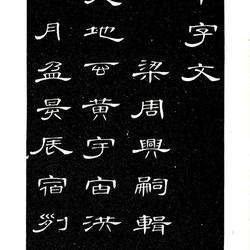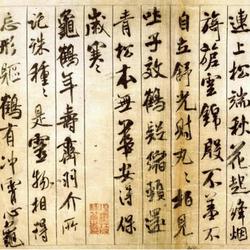"Thousand-Character Essay in Cursive Script"It is a rare long cursive scroll written by Huizong.It was written in 1112 (the year of Xuanhe and Renyin).In terms of his mastery of brushwork, composition and artistic conception, he is indistinguishable from Huai Su. This scroll of flying ink is written on a piece of paper with a total length of more than three feet, depicting gold clouds and dragons. The exquisite patterns at the bottom of the text were painted stroke by stroke by the palace painters. They complemented Huizong's calligraphy and together they created this unprecedented masterpiece! It is known as "the most unique calligraphy treasure in the world".
The length is 31.5 centimeters and the width is 1172 centimeters. It is written on a piece of paper with gold clouds and dragons all over it. This is Zhao Ji's exquisite work when he was forty years old. The writing style is bold and smooth, unpredictable, and completed in one go, which is quite spectacular. It is a masterpiece after Zhang Xu and Huai Su. It is now in the Liaoning Provincial Museum. Cultural Relics Publishing House and Shanghai People's Fine Arts Publishing House each have photocopied copies available. The overall atmosphere of this work can be said to be full of energy, and the whole work is as majestic as rushing water. The visual consistency is always an important factor in attracting the attention of the viewer, just as Tao Zongyi explained in "Shu Shi Hui Yao" General: "It is created by the will, and it cannot be achieved through physical traces."
This is a long scroll with cursive writing on it, which restricts the calligrapher's temperament to a certain extent. Why do you say that? Because the expression dimension of calligraphy is top-down, especially cursive script, some random strokes are often produced in the vertical space, and the space for horizontal expansion is very limited after all. Looking at this post, I feel full of vigor and vitality, and my spirit is leaping forward. Although it is a long scroll, the writing is full of vitality, beating endlessly, and there is no tiredness in the writing. When the vertical space is relatively small, Zhao Ji's use of long lines is also very appropriate. For example, the far drooping strokes at the end of the characters such as "Hao", "Di", and "Ye" in the article not only adjust the proportions of the space, but also make it clear and clear. , ups and downs, smart, full of high emotion and far-reaching, and at the same time it also plays the role of guiding and integrating, making the work appear more coherent. From this work, it is not difficult to find that Zhao Ji is good at using interspersed and scattered compositions. Perhaps, he got inspiration from Huang Tingjian's cursive script. Huang's cursive writing is well-proportioned and graceful. His representative work "Li Bai's Reminiscences of Old Travels" makes excellent use of the intrusion and interweaving of lines, making certain characters cross regions and invade the line space of other characters. This processing method makes the presentation of the composition no longer limited to a single row or column, but gives people the aesthetic feeling of "a street paved with rubble". The way of expression of invasion in Zhao Ji's work can be said to be the essence of Huang's work: strange at first glance, startling at second glance, and marvelous at third glance.
From this volume, we can also see Zhao Ji's "free" attitude when creating: for strokes, on the basis of ensuring the quality of the line, he wrote very quickly, powerfully, and wildly, inspiring the world, and there was a saying of "Who else can I do?" This work was made on paper depicting gold clouds and dragons. Due to the smooth surface of the paper, the pen and ink penetrate slowly. As a result, there are mostly sharp and sharp strokes throughout the text, while there are fewer subtle and blunt strokes. This may be a reflection of the part of the beauty that is lost due to the blind pursuit of momentum. In this way, the handling of painting, pinching, and turning points seems too fast and sharp. If it can achieve what Zhang Jie of the Song Dynasty said, "If it is released, it will be like the Yangtze River, with turbulent waves and endless rolling; if it is collected, it will be like the Yangtze River. "Hidden, appearing and disappearing, with various postures." It is indulgent and at the same time capable of being captured. Then the beauty that this volume brings to us may be richer - after all, subtlety can better arouse the aesthetic emotions of the viewer. .
"Involvement", as the key link between upper and lower characters, is the main expression in cursive script. A calligrapher who is good at writing rough cursive has a wonderful grasp of the implications: sometimes it is as thick as the main pen, sometimes as thin as a hairspring; sometimes it is pulled vertically, with the momentum of flying down; sometimes it is pulled obliquely, with the toughness of bending iron and steel. . It can be seen from this volume that Zhao Ji is good at using the diagonal pulling method. On the one hand, this shows his confident writing state: like an angry cat picking a stone, unstoppable, calm and joyful, passionate and unrestrained; but on the other hand, it also reveals his lack of flexibility in the way of implication, with too many diagonal lines. The whole article seems messy, samey and monotonous.

